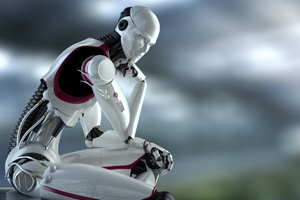Literature
We, Robot

Despina Kakoudaki’s new book analyzes artificial people in film and fiction.
Robots and androids hold a powerful sway on our cultural imagination. Countless science fiction books have depicted artificial intelligence, and robots battling humans for global supremacy is usually a summer blockbuster waiting to happen. Each new robot tale may seem cutting edge.
But as Despina Kakoudaki details in her new book, Anatomy of a Robot: Literature, Cinema, and the Cultural Work of Artificial People, this obsession with artificial intelligence is nothing new.
"I was interested in this topic because it seems to be perennially new, even though it is one of the oldest things in the book," says Kakoudaki, an American University professor in the Literature Department. "It's not even about modernity. It's not about the scientific revolution. It goes to antiquity. It goes to ancient origin stories and myths."
Origin Myths
Philosopher Aristotle used a lot of mechanical metaphors for the human body, she says. The story of God creating Adam was probably a paradigm for how the artificial creature in Jewish folklore, the Golem, was created.
"The stories of people who are artificially created are modeled on stories about the creation of people," says Kakoudaki, who teaches interdisciplinary courses in literature, film, technology, and visual culture.
She organizes the book around four commonalities in robot stories: the artificial birth; the mechanical body; the use of robots as slaves; and questions about what it means to be human (which she labels "the existential cyborg").
Despite similar patterns in ancient and modern animating fantasies, technology becomes more of a life-giving force in later works. She notes that in Mary Shelley's Frankenstein, Victor's monster is born adult—a frequent occurrence in stories of artificial people. "Everything that usually takes place inside the body is externalized: processes of conception and gestation are transformed into visible and instantaneous events, and the pain and mystery of childbirth are replaced by technological promises of clarity and control," she writes.
Thin Lines: Android and Human
There's often a sharp divide between human and robot. Yet other times, it's not so clear-cut. "A classic robot is metal and stilted, and it doesn't have a lot of human characteristics. It doesn't use slang terms, or possess humor or love. It would be easy for that to be so other, and for us to feel so human," she explains.
Yet sometimes the robot takes on human features. In the book, she draws a contrast between Iron Man's Tony Stark, a man inside the machine, and The Terminator's T-800 model, a machine inside what looks like a man.
"In the beginning of the first Terminator film, you have a range of human behaviors that are just abusive and horrible and murderous, and then it turns out that those were behaviors of this Terminator. But for a while, they look like human behaviors," she says.
Indeed, the Terminator series chips away at the wall between human and machine. In Terminator 2: Judgment Day, Arnold Schwarzenegger's cyborg learns human behavior and lingo from the character he's trying to save, John Connor. This creates some of the movie's most memorable lines, such as Schwarzenegger's famous, "Hasta la vista, baby!" She writes that "not only does it seem that the cyborg is learning, evolving, choosing, and changing its programming but also that it is finally doing some proper thinking."
Yet, in other instances, the human is envious of the robot. Lieutenant Commander Data from the TV series Star Trek: The Next Generation puzzles bystanders by his apparent inability to show emotion. "Our fascination with Data implies that sometimes we wish we did not feel emotion, either. It would be a kind of immunity," she says. Robot emulation is present in everyday life, she adds, when someone says, "I feel like a robot" or "I'm on automatic pilot."
Are We All Cylons Now?
Depictions of artificial people raise deeper philosophical questions about how we identify as humans. In Cold War America in the 1950s and 1960s, anticommunist paranoia and a racially-tinged fear of others were represented in science fiction. Author Philip K. Dick worked out of that tradition, she says.
Yet that vocabulary began to disappear. In the two versions of the TV series Battlestar Galactica, the cybernetic Cylons wage war on human civilization. But during the re-imagined series (2004-2009), Cylons also live amongst the humans and can have children with them.
"The story starts from this absolute distinction that is deadly," she says. "And then at the end it's almost like, 'Do you know how to cook? Do you know how to do anything on this planet? You're good enough! Let's just build something.'"
Does this reflect human progress? Well, maybe, maybe not. Kakoudaki avoids prophecies about where we're headed as a species, and she cautions against viewing each robot story solely as a product of its time period.
There's also a danger in viewing humans and robots too similarly. In the 2001 Steven Spielberg movie A.I. Artificial Intelligence, parents grieve when their son goes into a coma. To ease their pain, they adopt a robotic boy, but the human son soon wakes up. Trouble arises with two children together, and the parents banish the robot son to the forest.
Initially, it seems that there's a clear distinction between the real boy and the artificial boy. But on closer inspection, she says, the parents are cavalierly equating the two. "It's the parents' position of, 'We need to have a child. Where's the child? Give me a real one, give me an artificial one, I don't really care,'" she explains. "The artificial person actually reveals how endangered the real person was. That is why I think that they have a lot to teach us."

